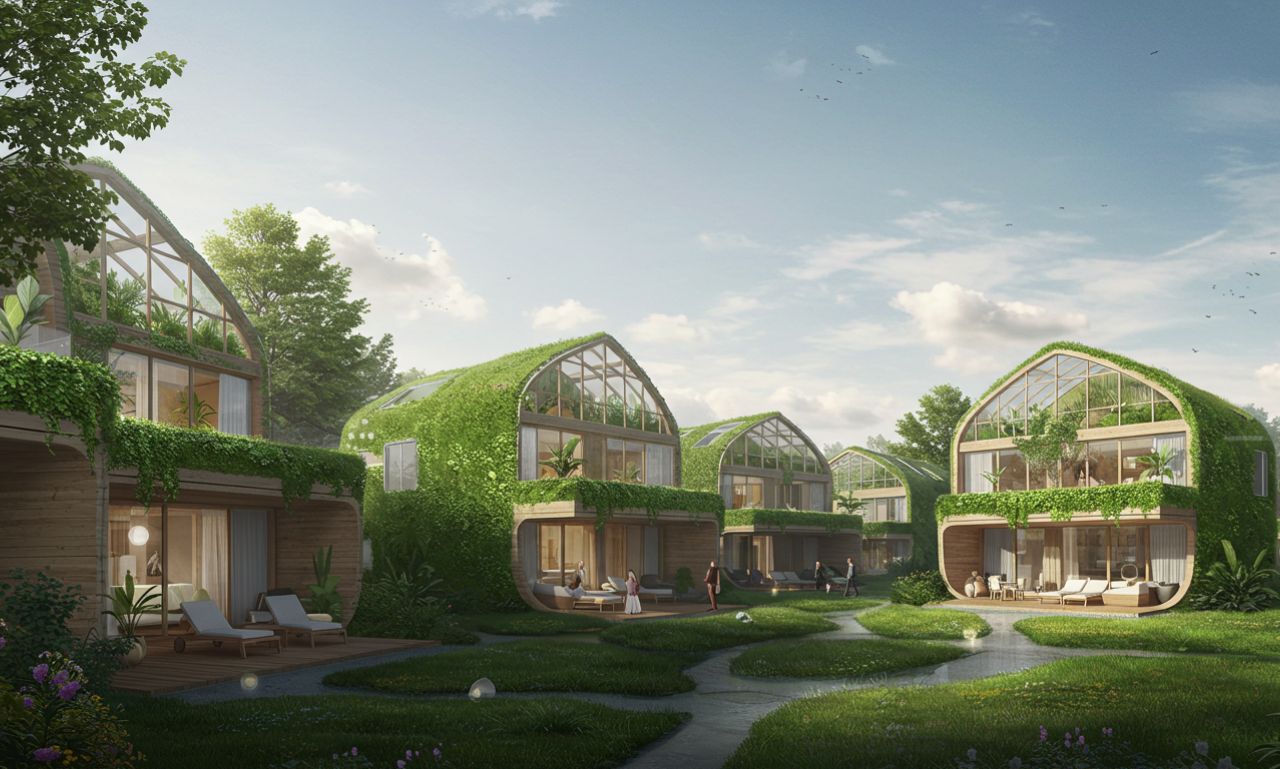Imagine living in a home that not only reflects your style but also cares for the environment. This is where Greenhouse Villas come into play, transforming sustainable architecture from a buzzword into a beautiful reality. These innovative homes blend modern design with eco-friendly practices, creating spaces that nurture both their inhabitants and the planet.
The concept of Greenhouse Villas goes beyond mere aesthetics; it embodies a lifestyle choice rooted in sustainability. With rising environmental concerns, more people are seeking ways to reduce their carbon footprint without sacrificing comfort or elegance. Enter Greenhouse Villas: where luxury meets responsibility in an inspiring way. Let’s dive deeper into this remarkable approach to living sustainably while enjoying the comforts of modern life.
What is Greenhouse Villas?
Greenhouse Villas are a revolutionary approach to modern living. These unique residences blend cutting-edge architectural design with eco-friendly practices.
Constructed using sustainable materials, Greenhouse Villas prioritize energy efficiency and environmental harmony. Each villa is designed with an emphasis on natural light, reducing the need for artificial lighting during the day.
The concept encourages residents to connect with nature. Large windows and open spaces create a sense of tranquility and peace. Additionally, green roofs and walls not only enhance aesthetics but also improve insulation.
These villas serve as more than just homes; they embody a lifestyle choice that supports sustainability. By incorporating smart technology, homeowners can monitor energy usage effectively while enjoying all the comforts of contemporary living.
This innovative design redefines what it means to live sustainably without sacrificing style or comfort.
Benefits of Sustainable Architecture
Sustainable architecture brings a multitude of rewards that extend far beyond aesthetics. One of the primary benefits is energy efficiency. Homes designed with sustainable practices often utilize renewable energy sources, reducing reliance on fossil fuels.
Additionally, these structures promote better air quality. By incorporating natural materials and ventilation systems, they create healthier living environments for occupants.
Cost savings are another significant advantage. Sustainable buildings typically lower utility bills through efficient design and technology. This translates into long-term financial benefits for homeowners.
Moreover, such designs enhance property value. As demand increases for environmentally friendly homes, investing in sustainable architecture can yield profitable returns down the line.
Sustainable architecture fosters community resilience by integrating green spaces and eco-friendly infrastructures that benefit local ecosystems while promoting a sense of belonging among residents.
Features of Greenhouse Villas
Greenhouse Villas are designed with a deep commitment to environmental harmony. Their architecture often includes large, strategically placed windows that invite natural light while reducing the need for artificial illumination.
These villas typically feature green roofs and vertical gardens that not only enhance aesthetics but also improve air quality. The integration of native plants promotes biodiversity and offers habitat for local wildlife.
Energy-efficient systems are another hallmark. Solar panels and rainwater harvesting systems minimize reliance on external resources, making the homes self-sufficient.
Interior spaces prioritize open layouts, enhancing airflow and comfort throughout the year. Natural materials such as reclaimed wood or bamboo create warmth while ensuring sustainability in construction practices.
Smart technology is seamlessly incorporated, allowing homeowners to monitor energy use in real-time, facilitating even greater efficiency without sacrificing style or comfort.
How Greenhouse Villas reduce carbon footprint and promote sustainability
Greenhouse Villas stand as a beacon of innovation in reducing carbon footprints. Their design integrates nature with architecture, allowing for energy efficiency without compromising on aesthetics.
These villas utilize renewable energy sources such as solar panels and wind turbines. This significantly lowers reliance on fossil fuels, cutting greenhouse gas emissions substantially.
The incorporation of green roofs and walls further enhances insulation. This not only keeps interiors comfortable year-round but also absorbs CO2 from the atmosphere.
Rainwater harvesting systems are another key feature. They collect water for irrigation and other non-potable uses, promoting responsible resource management.
By using sustainable materials like reclaimed wood and recycled metal, Greenhouse Villas minimize waste throughout their lifecycle. Each element is thoughtfully chosen to support environmental health while creating inviting living spaces that homeowners can cherish.
Impact on the environment and surrounding community
Greenhouse Villas create a profound impact on both the environment and local communities. These structures are designed to harmonize with nature, utilizing renewable materials that minimize ecological disruption.
By incorporating green spaces within their design, they enhance biodiversity. Native plants thrive alongside these villas, providing habitats for local wildlife and fostering an ecosystem that benefits everyone.
Communities also experience positive changes. Greenhouse Villas encourage residents to engage in sustainable practices like gardening and recycling. This shared commitment enhances community bonds as neighbors collaborate for a greener future.
Moreover, the energy efficiency of Greenhouse Villas reduces demand on local resources. Lower utility bills mean families can allocate funds towards other community initiatives or improvements.
The ripple effect extends beyond individual homes; it inspires neighboring developments to adopt eco-friendly designs too, creating a collective movement towards sustainability that uplifts entire neighborhoods.
Cost efficiency and long-term benefits for homeowners
Choosing greenhouse villas can significantly reduce living costs over time. These homes are designed with energy efficiency in mind, harnessing natural resources like sunlight and rainwater. This means lower utility bills for homeowners.
The materials used in greenhouse villas often lead to reduced maintenance expenses. Durable components and eco-friendly finishes require less frequent repairs or replacements. Homeowners can enjoy a comfortable home without the constant worry of costly fixes.
Additionally, these innovative designs increase property value. As sustainable living becomes more desirable, investing in a greenhouse villa today could yield substantial returns tomorrow. Buyers are increasingly aware of environmental impacts, making these homes attractive on the market.
Moreover, many local governments offer incentives for sustainable construction and renovation projects. Tax breaks or rebates can further enhance cost savings for owners of greenhouse villas—making sustainability not just an ethical choice but also a financially savvy one.
The future of sustainable architecture with Greenhouse Villas
The future of sustainable architecture is bright, particularly with innovations like Greenhouse Villas leading the charge. These structures blend nature and design seamlessly, creating living spaces that prioritize environmental health.
As urbanization continues to rise, the demand for eco-friendly housing will only grow. Greenhouse Villas represent a solution that meets this need while enhancing quality of life. By integrating green technologies and materials, these villas set a new standard for energy efficiency.
Advancements in building techniques are making sustainability accessible to more homeowners. With features such as solar panels and rainwater harvesting systems, these homes reduce reliance on traditional resources significantly.
Moreover, they foster community engagement through shared green spaces and gardens. This encourages residents to connect with each other and their environment in meaningful ways. As awareness about climate change escalates, models like Greenhouse Villas offer hope for a harmonious coexistence between humans and nature.
Conclusion
Greenhouse Villas represent a significant shift in how we think about living spaces and their impact on our planet. By embracing sustainable architecture, these villas not only provide comfort but also actively contribute to environmental health. Their innovative designs maximize natural resources while minimizing waste.
As communities become more aware of sustainability, the popularity of Greenhouse Villas is likely to grow. Homeowners can look forward to reduced energy costs and increased property values over time. This approach benefits not just individuals but entire neighborhoods that prioritize eco-friendly living.
The future of housing lies in models like Greenhouse Villas—where elegance meets environmental responsibility. Embracing this trend could lead us toward a greener, healthier world for generations to come.

